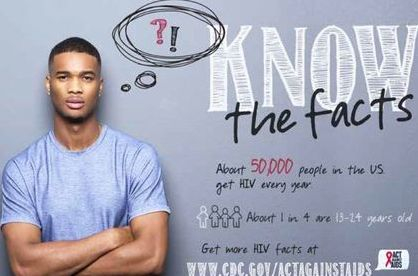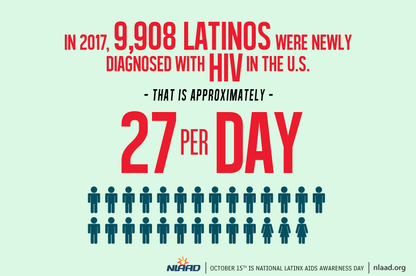Who is at Risk for HIV?

In the United States, HIV is spread mainly through anal or vaginal sex or by sharing drug-use equipment with an infected person. Substance use can contribute to these risks indirectly because alcohol and other drugs can lower people’s inhibitions and make them less likely to use latex or polyurethane condoms
Ethnicity
African Americans – African Americans are the racial/ethnic group most affected by HIV in the United States. Read more about prevention challenges for African Americans and what CDC is doing to address them in HIV Among African Americans.
More HERE
American Indians/Alaska Natives – HIV is a public health issue among the approximately 5.2 million American Indians and Alaska Natives (AI/AN), who represent about 1.7%a of the US population. Compared with other racial/ethnic groups, AI/AN ranked fifth in estimated rates of HIV infection diagnoses in 2013, with lower rates than in blacks/African Americans, Hispanics/Latinos, Native Hawaiians/Other Pacific Islanders, and people reporting multiple races, but higher rates than in Asians and whites. More HERE
Asians – According to the most recent United States census data, the Asian population in the United States grew 43%, or more than four times as fast as the total US population between 2000 and 2010. Despite this significant growth, the number of Asians receiving a diagnosis of HIV has remained stable in recent years. Overall, Asians continue to account for only 2% of new HIV infections in the United States and dependent areas. More HERE
Hispanics/Latinos – HIV is a serious public health issue in the Hispanic/Latino community. Read more about prevention challenges for Latinos and what CDC is doing to address them in HIV Among Hispanics/Latinos. More HERE
Native Hawaiians and Other U.S. Pacific Islanders – National estimates show that Native Hawaiians and Other Pacific Islanders (NHOPI) in the United States and dependent areas represent a very small proportion of HIV infections, compared with other races/ethnicities. More HERE

Age
Youth – Youth in the United States account for a substantial number of HIV infections. Gay, bisexual, and other men who have sex with men* account for most new infections in the age group 13 to 24; black/African American** or Hispanic/Latino gay and bisexual men are especially affected. Continual HIV prevention outreach and education efforts, including programs on abstinence, delaying the initiation of sex, and negotiating safer sex for the spectrum of sexuality among youth—homosexual, bisexual, heterosexual, and transgender—are urgently needed for a new generation at risk. More HERE
Older Americans – A growing number of people aged 50 and older in the United States are living with HIV infection. People aged 55 and older accounted for almost one-fifth (19%, 217,000) of the estimated 1.1 million people living with HIV infection in the United States in 2010. More HERE
Gender
Gay & Bisexual Men – Gay, bisexual, and other men who have sex with men (MSM) are more severely affected by HIV than any other group in the United States. Read more about prevention challenges for MSM and what CDC is doing to address them in HIV Among Gay, Bisexual, and Other Men Who Have Sex With Men. More HERE
Men – In 2010, an estimated 1.1 million people aged 13 years or older were living with HIV infection in the United States. Most (76%) of those living with HIV were male, and 69% of males were gay, bisexual, and other men who have sex with men (MSM). In 2010, the most recent year for which new HIV infection data are available, men accounted for 80% (38,000) of the estimated 47,500 new HIV infections. Most infections occurred in adults aged 25 to 34 years, except among black/African American men (referred to as “black” in this fact sheet), for whom 38% of all new infections occurred in the youngest age group, 13 to 24 years. More HERE
Pregnant Women, Children & Infants – HIV transmission from mother to child during pregnancy, labor and delivery, or breastfeeding is known as perinatal transmission and is the most common route of HIV infection in children. When HIV is diagnosed before or during pregnancy, perinatal transmission can be reduced to less than 1% if appropriate medical treatment is given, the virus becomes undetectable, and breastfeeding is avoided. Read more about prevention challenges for women and what CDC is doing to address them in HIV Among Pregnant Women, Children and Infants. More HERE
Transgender – Transgender communities in the United States are among the groups at highest risk for HIV infection. The term gender identity refers to a person’s basic sense of self, and transgender refers to people whose gender identity does not conform to a binary classification of gender based on biological sex, external genitalia, or their sex assigned at birth. It includes gender-nonconforming people with identities beyond the gender binary who self-identify as: male-to-female or transgender women; female-to-male or transgender men; two-spirit; and people who self-identify simply as women or men. More HERE
Women – Women account for one in four people living with HIV in the United States; African American women and Latinas are disproportionately affected at all stages of HIV infection. Read more about prevention challenges for women and what CDC is doing to address them in HIV Among Women. More HERE
Other
Other: Some groups merit special consideration because of their unique needs for HIV prevention. Find out more about prevention challenges for these groups and what CDC is doing to address them.